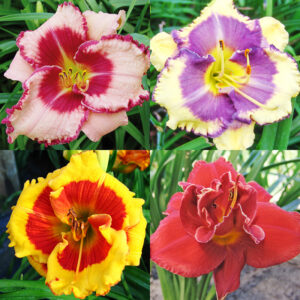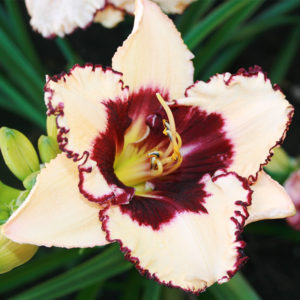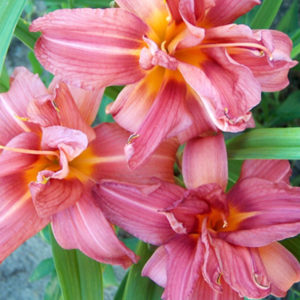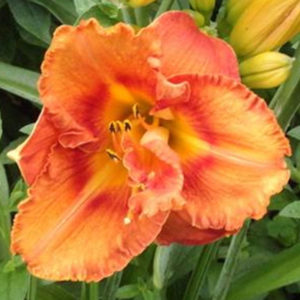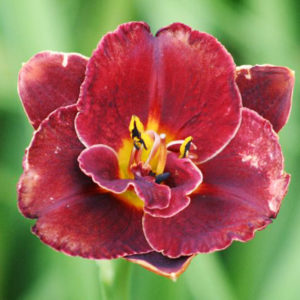Daylilies are one of the most beloved perennials. They tolerate difficult growing conditions and are considered one of the easiest perennials to grow. Not only are they easy to grow, they bloom in a variety of colors. The possibilities are nearly endless when it comes to daylily bloom color choices. According to the American Hemerocallis Society, there are over 60,000 registered varieties of daylilies. Therefore, collecting and adding daylilies to your garden could be a lifelong endeavor. Read more about adding these easy to grow perennials to your sun garden in our complete guide to growing daylilies.
Daylily Growing, Maintenance and Care Information
When is the best time to plant daylilies?
Bare root daylilies can be planted in spring or fall. In colder climates planting daylilies in spring is preferred. When planted in spring they will have more time to establish roots before winter.
When planting bare-root daylilies in fall be sure they are in the ground at least 6 weeks before the ground usually freezes for winter. In areas that the ground does not freeze during winter, daylilies can be planted in either spring or fall.
Where to plant daylilies?
Daylilies tolerate a range of growing conditions. They only have a couple requirements for success. Plant daylilies in an area that receives at least 6+ hours of sun per day. Daylilies tolerate poor soil however, they will grow best in soil with good drainage.
When choosing a planting location consider an area that the daylilies can be mixed in with other sun-loving perennials. When daylilies are not blooming the foliage is not too exciting; therefore planting other perennials helps them blend in better.
What hardiness zones are best for growing daylilies?
Daylilies grow best in hardiness zones 3-9. Daylilies grow in the majority of the United States, from north to south, east to west, and most states in between. Only the extremely cold and warm areas will not be able to grow daylilies.
Can daylilies be grown in pots?
Daylilies can temporarily be grown in pots in most climates. However, growing daylilies in pots in climates that freeze in winter will pose some challenges. During the winter if the daylilies are left in the pots the freeze and thaw cycles can damage the roots causing the plant to die over winter. Therefore, when planting daylilies in pots in cold climates it is best to transplant them to the ground before winter. Gardeners in warmer climates can grow daylilies in pots for longer. However, they will need to be transplanted into the ground or a larger pot after a couple of years.
Do daylilies grow from a bulb or a root?
Daylilies grow from a root. Their roots often resemble a clump of dahlia tubers.
Do daylilies spread?
Old fashioned varieties of daylilies spread and can take over an area. Sometimes called tiger lilies or ditch lilies these old varieties have tall stems with orange flowers in summer. They can colonize an area by spreading underground.
Newer hybrids of daylilies stay in a clump. They do not colonize or spread readily like the older varieties. When shopping for daylilies know that most varieties available from garden retailers will be selling the clump-forming varieties that do not spread and colonize.
Do daylilies need to be divided?
Divide daylilies every 3, 5, or 7 years. Dividing daylilies will produce more daylilies for your garden and to share with friends. When daylilies stop blooming that is a good indicator it is time to divide the clumps.
To divide daylilies dig up the entire clump from the garden. Use a shovel to dig up the clump. When the clump is out of the ground take a garden spade or sharp translating tool to break the clump up. The amount of daylilies you will get from this clump depends on the size of the clump.
Once the clump is divided the divisions should be re-planted right away. When re-planting daylilies provide plenty of extra water. The dividing process and transplanting process can create extra stress on the plants. Providing extra water after transplanting can help ease the stress.
Daylily Blooms
When do daylilies bloom?
Daylilies bloom in summer. Most varieties of daylilies begin blooming in early to mid-summer. Re-blooming daylilies will start blooming in mid-summer through early fall.
How long do daylilies bloom?
The single bloom from a daylily flower only lasts one day. The botanical name for daylily is Hemerocallis which translates to “beautiful for a day” and therefore, why they are called daylilies. While the individual blooms only last one day most daylilies will produce flowers for at least 1-2 weeks in summer. Re-blooming daylilies like Stella D’Oro Daylily will bloom for a couple of months in summer. Some re-blooming varieties of daylily will put on their initial blooms in mid-summer and then again in late summer.
Planting different cultivars of daylilies is the best way to extend the daylily bloom time in the garden. Since some varieties bloom earlier than others, and some daylilies bloom continuously planting a few different types can ensure blooms for several weeks in summer.
What colors do daylily flowers bloom in?
Daylilies bloom in nearly every color in the rainbow except for blue and green. It is common for daylilies to have multiple colors in the petals. Some will have a different center color than the outer parts of the petals. Some daylilies will have an outer ring or lining on the petals that is a different color. The color options in daylily blooms make them easy to incorporate into a full sun garden location; they can match most color schemes.
In addition to daylilies blooming in a range of colors, some varieties bloom with double the petals. Double blooming daylilies have double the petals for a full and lavish appearance.
Daylilies: the Easy to Grow Solution for Sunny Gardens
Daylilies are at the top of the list for easy to grow perennials. They are low maintenance and thrive under adverse growing conditions. Beginner gardeners should add daylilies to their list of perennials for sunny areas. They are nearly impossible to kill. Therefore, if you don’t consider yourself a skilled gardener daylilies may be the plant to give you the confidence boost you need!
Looking for other easy-to-grow perennials and bulbs? We have a list of 10 Beginner-Friendly Bulbs and Perennials, check it out here.


